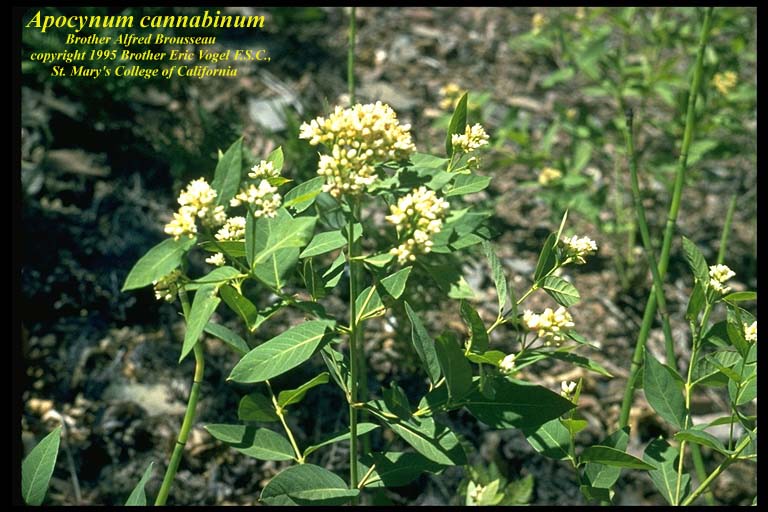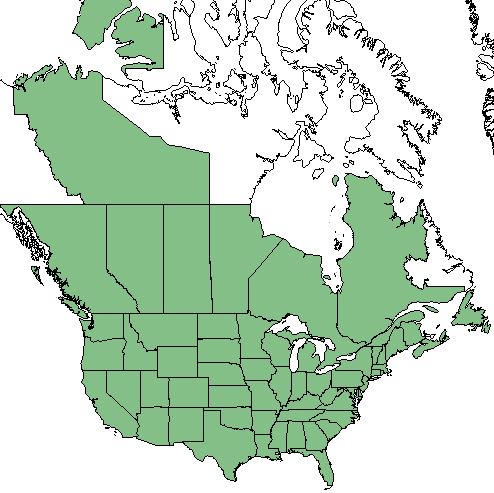Apocynum cannabinum
Common names: hemp dogbane; Indian-hemp
| Apocynum cannabinum | |
|---|---|

| |
| Photo by the Atlas of Florida Plants Database | |
| Scientific classification | |
| Kingdom: | Plantae |
| Division: | Magnoliophyta - Flowering plants |
| Class: | Magnoliopsida - Dicots |
| Order: | Gentianales |
| Family: | Apocynaceae |
| Genus: | Apocynum |
| Species: | A. cannabinum |
| Binomial name | |
| Apocynum cannabinum (L) | |

| |
| Natural range of Apocynum cannabinum from USDA NRCS Plants Database. | |
Contents
Taxonomic Notes
Synonyms: Apocynum cannabinum var. cannabinum[1]
Varieties: Apocynum cannabinum var. pubescens (Mitchell) Woodson; Apocynum cannabinum var. nemorale (G.S. Miller) Fernald; Apocynum cannabinum var. glaberrimum A.L.P.P. de Candolle; Apocynum cannabinum var. greeneanum (Béguinot & Belosersky) Woodson[1]
Description
A. cannabinum, also known as Indianhemp, is a native member of the Apocynaceae family, with a perennial forb growth habit.[2] It grows to a height between 2 to 4 feet with erect branches and sharp-pointed leaves.[3] It also is a tough and fibrous plant which produces a milky latex sap like other Milkweeds. The A. cannabinum root system consists of horizontal roots and short rhizomes.[4] Flowers are small and inconspicuous, greenish pink in color, and cylindric to urn-shaped. The fruit is long and pendant, with a slender and cylindric shape. Fruit splits open when mature, and fruit has long tufts of silky hairs.[2]
Distribution
In Florida, reports of A. cannabinum range from Escambia County, eastward to Clay and Volusia Counties, and southward to Hernando and Brevard Counties.[5] Otherwise, it can be found throughout the United States in thickets and borders of old fields in pine forests.[3] The species can be seen as a generalist and can grow in numerous types of habitats, but is most common along shores and flood plains.[4]
Ecology
Habitat
A. cannabinum can be found in natural communities as well as human disturbed habitats across the United States.[3] It has been described as occurring in cedar glades, prairies, barrens, and various types of disturbed sites,[6] and in mountain longleaf pine communities.[7] The species can be found over a wide variety of soil types, including dry soil, sandy soil, rocky soil, alluvial gravel, silt, loam, clay, calcareous soil, mineral soils near hot springs, and sometimes peaty soil.[4] For disturbed sites, A. cannabinum can be found in damp swales adjacent to roads, in old fields, weedy roadsides, wastes, banks, and other types of roadsides.[8]
Phenology
A. cannabinum has been observed to flower from April to August with peak inflorescence in May.[9][10] Seed production occurs in the summer and matures in the fall, which can be found in the follicle of the species. Aside from this form of reproduction, A. cannabinum can also reproduce from vegetative reproduction in the rhizomes.[4]
Seed dispersal
The seeds are adapted with white silky hairs for wind dispersal like other milkweeds, and the light-weight seed is also able to float to conduct water dispersal.[4]
Seed bank and germination
In the field when A. cannabinum has been seen to be frequent in the community, it has a low presence in the seed bank.[11] Seed dormancy in A. cannabinum can range from 50% to essentially no seed dormancy and germination occurring within a year of burial. For temperature, Apocynum cannabinum germinates at a range of 20-35° C.[4]
Fire ecology
It has been found that burning A. cannabinum in the fall eliminates dead stalks and in turn stimulates new growth. This causes the new growth to have taller and straighter stems with longer fibers, and stimulates flower and fruit production.[2]
Pollination
A. cannabinum is predominantly pollinated by insects attracted to the fragrance and nectar of the flower.[4] This species has been observed to be visited by ground-nesting bees such as Andrena wilkella (family Andrenidae), bees from the family Apidae such as Ceratina calcarata and C. strenua, and sweat bees from the Halictidae family such as Augochloropsis metallica, Halictus confusus, Lasioglossum foxii and L. perpunctatum. A. cannabinum has also been observed with plasterer bees from the Colletidae family such as Hylaeus fedorica, H. illinoisensis, H. mesillae, H. modestus and H. punctatus, as well as leafcutting bees from the family Megachilidae such as Heriades carinata, Megachile centuncularis, Megachile petulans and Megachile rotundata.[12]
Herbivory and toxicology
This plant has been observed to host sweat bees from the family Halicitidae such as Augochlora pura and Augochlorella aurata[13], plant bugs such as Lygus lineolaris (family Miridae), bees such as Macropis nuda (family Melittidae), aphids such as Aphis sp. (family Aphididae), froghoppers such as Philaenus spumarius (family Cercopidae), and ladybugs such as Harmonia axyridis (family Coccinellidae).[14] It has also been observed that syrphid and tachinid fly species visit the flower.[15] The species receives its herbivore damage from generalist insects found within the community.[4] A. cannabinum is also a food source for adult monarch butterflies (Danaus plexippus) and was once thought to be a food source for Monarch larvae, yet it has been shown that offspring oviposited on the plant will not mature.[10] Like other milkweeds, it is foraged by white-tailed deer yet it is not a substantial food source.[16] It is a host plant to the blue milkweed beetle (Chrysochus cobaltinus), which can cause severe defoliation; larvae of the beetle feed only on roots.[17] The species overall supports conservation biological control through attracting predatory/parasitoid insects that prey upon pest insects.[10]
Conservation, cultivation, and restoration
A. cannabinum is considered to be a weedy or invasive plant in natural communities, where it can become aggressive and hard to control.[10] It is also listed as endangered and extirpated in the state of Maryland.[2]
Cultural use
Historically, Native Americans have harvested Indian hemp for its fiber. The process includes cutting the stems in the fall, and splitting them open to find the long silky fibers. These fibers are twisted into string to eventually make cordage for ropes, thread, baskets, netting, snares, various clothing, and others. It is also specifically useful in creating carrying and fishing nets as well as weaving rough cloth. It is an important plant for tribes in the Columbia plateau in Washington, Idaho, and Oregon, and other tribes including the Quinalt, Nes Perce, Kalispel, Spokane, Wasco, Umatilla, Klikitat, and Yakima.
Medicinally, A. cannabinum can be prepared in multiple ways to help with various ailments. It can be dried, crushed, and snuffed to treat coughs in head colds, and the root was made into a tea to treat a baby's cold, headache, earache, dizziness, nervousness, and insanity. The tea was also used for heart palpitations, and the root can be used for a wide range of ailments pertaining to digestive health, since Indian hemp has been seen to stimulate the digestive system.[2] However, the plant as a whole is poisonous if ingested without preparing properly due to resins and cardiac glycosides.[2]
Photo Gallery
References and notes
- ↑ 1.0 1.1 Weakley, A.S. 2020. Flora of the Southeastern United States. Edition of 20 October 2020. University of North Carolina at Chapel Hill, Chapel Hill, North Carolina.
- ↑ 2.0 2.1 2.2 2.3 2.4 2.5 USDA Plants Database URL: https://plants.usda.gov/core/profile?symbol=APCA
- ↑ 3.0 3.1 3.2 Sievers, A. F. (1930). American medicinal plants of commercial importance. Washington, USDA.
- ↑ 4.0 4.1 4.2 4.3 4.4 4.5 4.6 4.7 DiTommaso, A., et al. (2009). "The Biology of Canadian Weeds. 143. Apocynum cannabinum L." Canadian Journal of Plant Science 89: 977-992.
- ↑ Observation by Roger Hammer in Falling Waters State Park, Washington County, FL, January 9, 2018, posted to Florida Flora and Ecosystematics Facebook Group August 4, 2017
- ↑ Baskin, C. C. and J. M. Baskin 2003. The Vascular Flora of Cedar Glades of the Southeastern United States and Its Phytogeographical Relationships. Journal of the Torrey Botanical Society 130:101-118.
- ↑ Cipollini, M. L., J. Culberson, C. Strippelhoff, T. Baldvins and K. Miller 2012. Herbaceous plants and grasses in a mountain longleaf pine forest undergoing restoration: a survey and comparative study. Southeastern Naturalist 11:637-668.
- ↑ Florida State University Robert K. Godfrey Herbarium database. URL: http://herbarium.bio.fsu.edu. Last accessed: June 2018. Collectors: Loran C. Anderson, George P. Sawyer Jr., Harry E. Ahles, Norlan C. Henderson, Tom Daggy, S/ F/ Blake, George T. Jones, Robert K. Godfrey, R. L. Lazor, Michael B. Brooks, Sidney McDaniel, Delzie Demaree, Clyde F. Reed, R. L. Wilbur, R. Kral, and S. W. Leonard. States and counties: Florida: Wakulla, Jefferson, Franklin, Gadsden, Suwannee, Jackson, Flagler, Taylor, Dixie, and Washington. Georgia: Thomas, and Clarke. Maryland: Baltimore, and Harford. Utah: Grand. Alabama: Geneva. Louisiana: Caddo. Massachusetts: unknown. North Carolina: Wake, Mecklenburg, Franklin, Gates, Currituck, and Granville. Mississippi: Harrison, Lowndes, and Okibbeha. California: Fresno. Arkansas: Pulaski, St Francis, and Marion. Indiana: Vanderburgh, Huntington, and Monroe. Texas: Freestone, Callahan, and Roberts. Missouri: Atchison, Barry, Greene, and Buchanan. Tennessee: Sumner. Ohio: Ashland. Virginia: Arlington. Illinois: White. West Virginia: Lewis.
- ↑ Nelson, G. PanFlora: Plant data for the eastern United States with emphasis on the Southeastern Coastal Plains, Florida, and the Florida Panhandle. www.gilnelson.com/PanFlora/ Accessed: 14 MAR 2019
- ↑ 10.0 10.1 10.2 10.3 [[1]] Lady Bird Johnson Wildflower Center. Accessed: March 14, 2019
- ↑ Leck, M. A. and C. F. Leck (1998). "A ten-year seed bank study of old field succession in central New Jersey." The Journal of the Torrey Botanical Society 125(1): 11-32.
- ↑ Discoverlife.org [2]
- ↑ Grundel, R., et al. (2011). "A survey of bees (Hymenoptera: Apoidea) of the Indiana Dunes and Northwest Indiana, USA." Journal of the Kansas Entomological Society 84(2): 105-138.
- ↑ Discoverlife.org [3]
- ↑ Tooker, J. F., et al. (2006). "Floral host plants of Syrphidae and Tachinidae (Diptera) of central Illinois." Annals of the Entomological Society of America 99(1): 96-112.
- ↑ Gee, K. L., et al. (1994). White-tailed deer: their foods and management in the cross timbers. Ardmore, OK, Samuel Roberts Noble Foundation.
- ↑ Borders, B. and E. Lee-Mader 2014. Milkweeds: A conservation practitioner's guide. The Xerces Society for Invertebrate Conservation, Portland 146 pg.